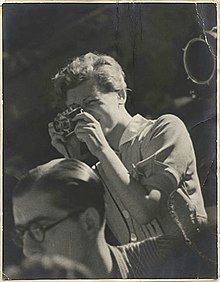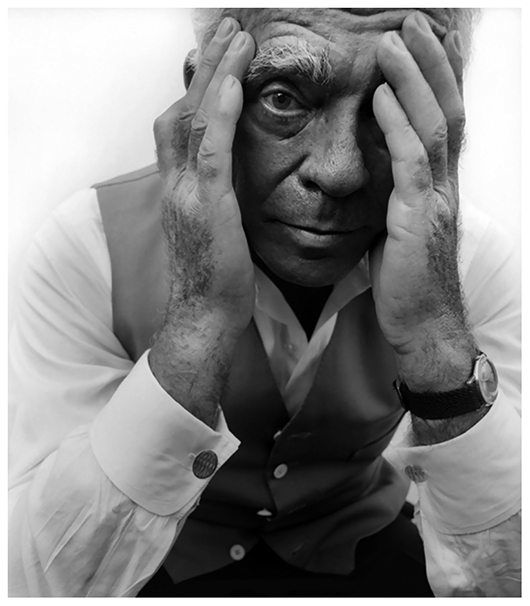Gerta Pohorylle, known by her pseudonym, Gerda Taro (Stuttgart, Germany, August 1, 1910 – El Escorial, Spain, July 26, 1937), was a pioneering German war photojournalist. Together with her partner, they photographed under the alias of Robert Capa, making it difficult to know which photos are of each one. She is considered the first female photojournalist to cover a war front and the first to die doing so.
Gerda Taro's real name was Gerta Pohorylle and she was the daughter of a Polish-Jewish family. Despite her bourgeois origins, from her youth she was part of socialist and labor movements. For this reason, with the rise of the Nazis to power and after having been arrested in 1933, she decided to flee with her friend Ruth Cerf to Paris.</ P>
A year later, in Paris, she met Endre Ernő Friedmann, a Hungarian Jew who made a living as a photojournalist who modeled after Cerf. Pohorylle accompanied her friend to the photo shoot and there she met Friedmann. The couple ended up falling in love. She learned photography and he refined her manner. Gerta and Endre began a relationship and he shared her photography knowledge with Gerta.
Since life as photographers did not meet their economic needs and they could not find a stable job, Gerda and Endre invented a character named Robert Capa, who was supposedly a renowned photographer from the United States to work in Europe. This fictional character was so famous that he sold photos of him through his representatives: Friedmann and Pohorylle, at triple the price of a French photographer. This trick worked perfectly and after a short time they received a large number of orders that generated economic income. Ruth Cerf and Imre Weisz (Csiki) also worked in the workshop they had in Paris
In 1936 the Spanish Civil War began, so they moved to Spain to cover the conflict. They witnessed different episodes of the war, and made reports that were later published in magazines such as Regards or Vu.
At first the brand name «Capa» was used interchangeably by both photographers. When there was some distance between them, Endre Friedmann stuck with the name "Robert Capa". Shortly before her death, she would begin to use the signature "Photo Taro".
Of Taro's solo work, the most important report of hers was that of the first phase of the battle of Brunete. He witnessed the republican triumph in this first phase of the battle. The report was published in Regards on July 22, 1937 and earned him great prestige.
However, soon after Franco's troops began a counterattack, and Taro decided to return to the battlefront in Brunete. There he witnessed the bombardments of the rebel side's aviation, and took many photographs, endangering his life. That battle ended in defeat for the Republican side.
Gerda Taro lost her life in an accident during the withdrawal of the Republican army. She gerda she got on the running board of General Walter's car (a member of the International Brigades). At one point, some enemy planes flying at low altitude caused the convoy to panic and Gerda fell to the ground, after a small rise in the ground. At that moment, a Republican tank reversed onto the road, jumping over the hill behind which Taro was standing and fell on it. The accident left her seriously injured and she was urgently transferred to the English hospital of El Goloso in El Escorial. She died there a few hours later, in the early morning of July 26, 1937, six days before her 27th birthday. Since she did not carry her passport with her, she was not recognized and she was going to be buried in a common grave. From the hospital they called Rafael Alberti and María Teresa León, leaders of the Alliance of Antifascist Intellectuals of Madrid, so that they would recognize her and give her a dignified burial. Her body was transferred to Paris, where she received all the honors as a republican heroine. Her remains are buried in division 97 of the Père-Lachaise Cemetery, 5 in Paris.
On September 26, 2007, the International Center of Photography opened its first major exhibition of Gerda Taro's photographs in the United States.
In the summer of 2016, an outdoor exhibition of photographs from the Spanish Civil War, taken by Taro, was part of the f/stop photography festival in Leipzig. When the festival ended it was decided that the exhibit, paid for in part by crowdfunding, would become permanent. Shortly after, on August 4, the display of Taro's work was destroyed with stains of black paint. With a crowdfunded project to restore the work underway, the destroyed work now remains in place. The destruction is suspected to have been motivated by anti-refugee or anti-Semitic sentiments.
The novel Waiting for Robert Capa, by Susana Fortes (2011, English translation by Adriana V. López), is a fictional account of the lives of Taro and Capa.
The documentary film, The Mexican Suitcase (2011), tells the story of a suitcase of 4,500 lost negatives photographed by Taro, Capa and David Seymour during the Spanish Civil War. The suitcase and negatives are currently at the International Center of Photography in New York City. The stage play Shooting With Light, produced by the Idle Motion theater company, is based on this film.
In sorting through the works in this collection, it was discovered that many photographs once attributed to Capa are actually by Taro, allowing for a better understanding of her contribution to photojournalism. Describing a difference in her style compared to Capa's, curator Kristen Lubben said: [On Taro]
"Your photographs are very more posed, with sharp camera angles. Capa was much more focused on movement."
The song "Taro" by British indie rock band alt-J is about her role as a war photographer during the Spanish Civil War, as well as her relationship with Cape. The song describes the graphic details of Capa's death and imagines Taro's complementary emotions.
In 2017, the Madrid City Council decided to name a street in the city in honor of Gerda Taro, in the case of the street that goes from Avenida de la Victoria to Calle Durango; It is located northwest of the city center along the A-6.7 motorway
The city of Paris did the same in 2019 with the new Rue Gerda Taro, in the 13th arrondissement, unanimously by the political groups of its City Hall.
In 2018, the city of Leipzig named a new gymnasium (a secondary school) for 1,200 students after Taro, finalizing the display of her photographs on display permanent.
she was featured in the Google doodle on August 1, 2018.
(Source Wikipedia)
Look at some of the pictures of her








 English (United Kingdom)
English (United Kingdom)